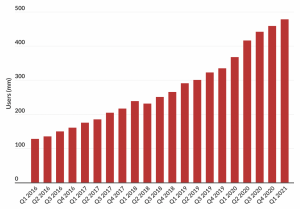Why you should add Pinterest to your marketing strategy
By: Thomas Parkinson
May 31, 2021 | Reading Time: 4 mins
As marketers (and human beings) we’re constantly searching for the next new and exciting innovation to make our lives even better. The newest software, the latest trend, a better way to push things forward. But, if there’s one thing I’ve learned from How I Met Your Mother, it’s that new isn’t always better.
While it’s a marketer’s job to stay on top of new trends and emerging tactics, we can’t lose sight of the wants and needs of our clients. Part of that means doing what makes sense rather than what’s flashy. The other part of that means working within a budget and adjusting your stack accordingly. While we’d all love to take augmented reality for a spin, sometimes the better solution is the simple solution.
This brings me to Pinterest, infamously dubbed, the ‘the mom app’.
Launched in 2010, it isn’t cutting-edge by any means. But over the last few years, usage has steadily increased. While it may not be dominating headlines like Clubhouse and TikTok, it’s still worth asking: should more businesses be using Pinterest?

What you probably didn’t know about Pinterest
With everything that’s gone on recently with Facebook boycotts and new Twitter rollouts, I understand if you’ve fallen behind on Pinterest. If that’s the case, here’s what you’ve missed:
- Pinterest has 478 million monthly active users, nearly double that of LinkedIn (250 million active monthly users).
- Pinterest drives 3.8x more sales than other platforms and 87% of Pinners have purchased a product because of Pinterest
- The platform generated $1.6 billion in revenue through 2020—a 45 percent increase year-over-year
- 77% of weekly Pinners discover a new brand or product on Pinterest
- While 60% of Pinterest users are women, male users are up 50% year-over-year
- 40% of Pinners have a household income of $100k+
How are businesses using Pinterest successfully?
As with any social media platform, there’s no official roadmap to follow. Every business is different and has varying perceptions of success. With that in mind, here are a few different ways companies are leveraging the platform:
To drive e-commerce: Ruggable uses the ‘Shop’ tab to make it easy to browse and buy right then and there. They aren’t the biggest brand, but with over 10m+ monthly views, Pinterest has helped them generate a ton of traffic and sales through in-app purchasing.
Sharing tutorials and how-to content: Brands like Chik-fil-A share recipes and step-by-step tutorials on how to prepare your favourite Chik-fil-A items at home. Sharing guides and how-to content is an easy way for companies to show off their industry know-how and build trust with their audience.
Adding brand personality/attracting talent: Pinterest isn’t just for foodies and home décor, with companies like Salesforce leveraging the platform to show off some personality and highlight team members. They have a board titled “I love working at Salesforce because…” filled with employee photos and statements about why they love working there. Rather than using Pinterest simply to engage with customers and prospects, Salesforce uses it to attract potential employees as well.
Using Pinterest as an ad tool: Like Facebook, Twitter, and other popular social media platforms, businesses can run targeted ads on Pinterest as well. Users can identify their target audience by demographic, interests, keywords, and more, or use auto-targeting to leave it up to Pinterest to find interested users. With over 78k followers, IKEA is a great example of a company using Pinterest ads to raise brand awareness and drive traffic to its channels.
What Pinterest is and what it isn’t
Pinterest doesn’t have anything close to a Facebook-sized audience. It’s not new or trending like Tik Tok, either. Honestly, it’s not going to be a fit for every business out there.
HOWEVER…
What Pinterest is, is a space where people are open-minded. They’re not doomscrolling or fighting off FOMO. Instead, they’re looking to try new things, save new ideas, and make their next purchase.
This year, we began taking a closer look at Pinterest for our own marketing. Considering the low risk, low commitment, and non-existent cost, we decided to give it a try. While it’s too early to gauge results, what’s important is that we’re trying.
Really, what’s the worst that can happen? If anything, we’ll discover Pinterest isn’t the place for us. We’ll find out what doesn’t work for its users. That’s OK! Because on the flip side, we could strike gold and discover a niche audience we didn’t know about.
Ultimately, you won’t know until you try, because in marketing (and life):






